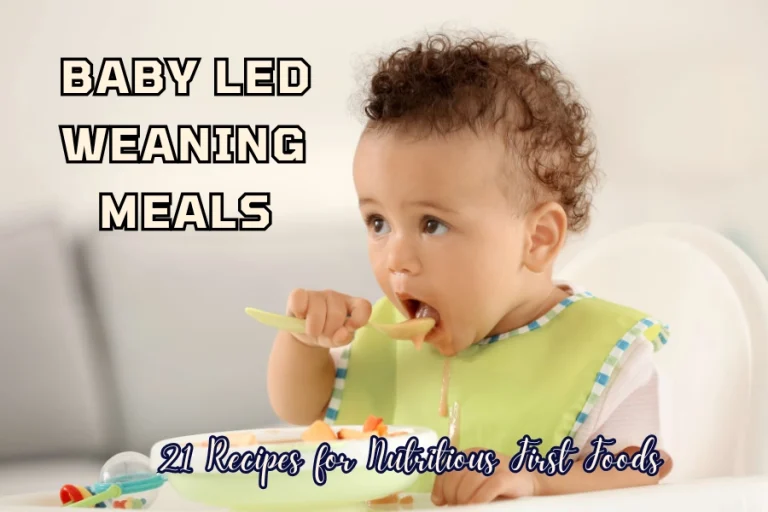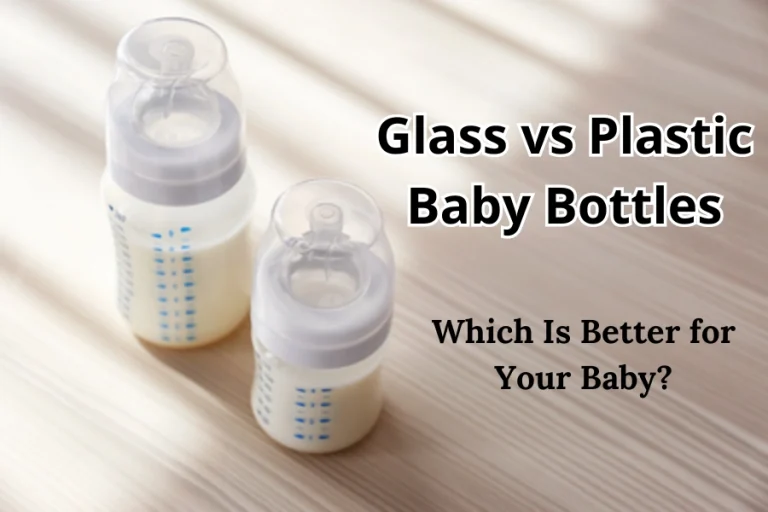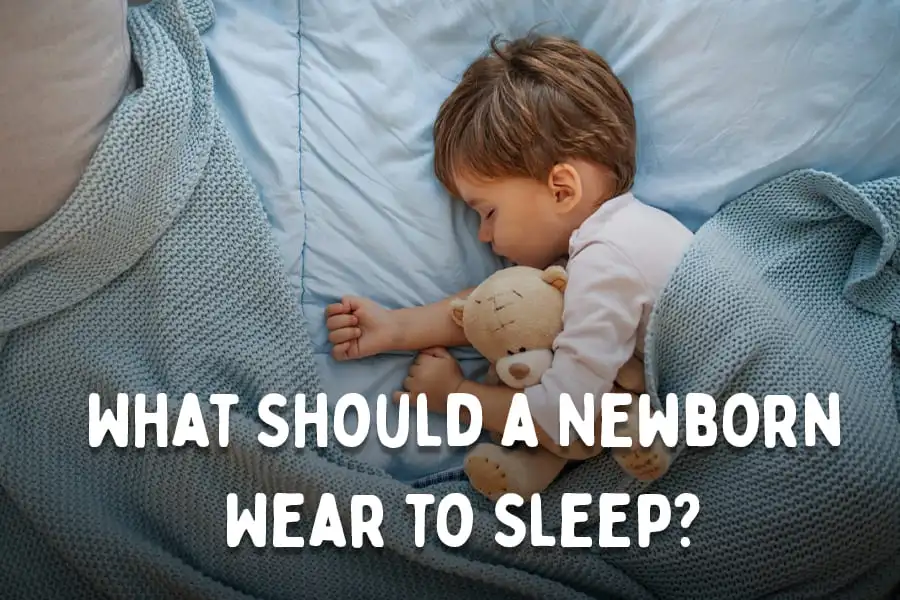
Newborn babies have just been welcomed into this world with the love and care of their families since they were still in the mother’s womb. It’s sensitive to everything: the small size, the new atmosphere, and the clothes on its body. These new things will have a big impact if there are no appropriate elements for newborns. So, with that soft, pinkish-white but no less sensitive skin, what should newborns wear to sleep? And what’s the right temperature for them to adapt? Dive into dreamland outfits! Explore comfy, breathable sleepwear for newborns that keeps them cozy without overheating.
What should a Newborn Wear to Sleep?
One of the most basic principles when wearing sleepwear for newborns is to balance warmth and avoid overheating so that babies can sleep safely.
Experts recommend dressing your baby in one or more layers of sleepwear to keep them warm without using blankets.1 Blankets should be kept away from the bed as they may increase the risk of suffocation, suffocation, and Sudden Infant Death Syndrome (SIDS). Experts recommend that co-sleeping with your baby for at least the first 6 months will bring a feeling of safety and comfort.2
Layering allows you to adjust the amount of clothing based on the room temperature (The ideal temperature is 68-72°F). If your home is cooler or warmer, adjust your child’s clothing accordingly. Jumpsuits can be a good base layer and extra clothing can be worn in cooler rooms as children are more comfortable with the cool than the heat. This ensures your baby is always warm and safe for peaceful sleep.
Advantages and disadvantages of swaddling your baby
Swaddling, the habit of wrapping babies tightly, became popular. It is estimated that 90% of newborns in North America are swaddled during the first few months of life.3 Parents use it to soothe fussy newborns and encourage them to sleep safely on their backs.
While swaddling can be a useful tool, it’s important to understand both the advantages and disadvantages to ensure your baby’s safety and comfort.
Advantages
Improves sleep: Recreating the feeling in the womb, helps your baby sleep better and with less interruption due to the startle reflex.
Reduces crying: Research by the National Institutes of Health (NIH) (.gov) shows that comfortable swaddling, combined with sound and movement, can help some babies stay calm and undisturbed in their sleep.
Developmental benefits for premature babies: Swaddling may promote better nerve and muscle development, as well as improve motor skills in premature babies.
Safer sleeping position: Swaddling can encourage parents to place their baby on their back, which is a safe sleeping position for their baby.
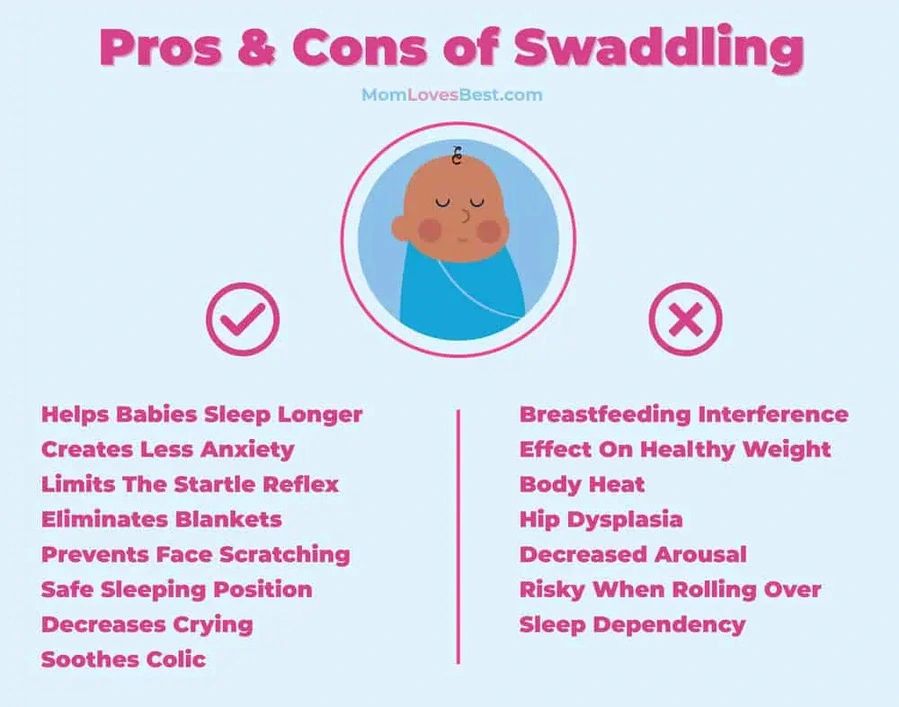
Disadvantages
Increased Risk of SIDS: One of the biggest concerns is the potential link between swaddling and Sudden Infant Death Syndrome (SIDS). Some studies suggest that swaddling may lower a baby’s arousal, making it harder for them to wake themselves if needed. This could be a risk factor for SIDS, although more research is needed to fully understand the connection.
Overheating: Swaddling adds an extra layer of fabric. This layer can trap heat and cause overheating. This is especially concerning in warm weather or if you have a baby who tends to run hot. Always monitor your baby’s temperature and adjust clothing accordingly when swaddling.
Hip Dysplasia: Improper swaddling can cause hip dysplasia. This is especially true if it keeps your baby’s legs tight and straight. It limits healthy hip development and increases the risk of hip dysplasia. For proper hip development, your baby’s legs need to move freely.
Loose bedding: If the diaper is not securely wrapped, it can come loose during sleep. This raises the baby’s risk of suffocation by covering his face. Always make sure the blanket is snug but not too tight, and avoid using loose blankets in the crib.
Difficulty moving: At around 2-3 months old, babies start to show signs of rolling over. At that time, swaddling will be very dangerous because the baby will not be able to roll back while swaddling. You must stop swaddling when your baby shows signs of rolling over. Then, transfer them to a sleeping bag that allows leg movement.
How to Swaddle Your Baby
Swaddling can be a great way to keep your baby calm and cozy, but safety is most important. Here are the things to remember:
- Always place a swaddled baby on its back to sleep, helping to reduce the risk of suffocation when sleeping on his stomach or side.
- A crib must fit snugly but still let the baby breathe comfortably. Avoid wrapping too tightly as this can restrict movement and potentially harm your baby’s hips.
- Swaddling can trap heat. Look for signs your baby is overheating, like sweating, flushed cheeks, or hot skin. Wear them lightly and keep the room cool.
- Wrapping in a weighted blanket can increase the risk of overheating and difficulty breathing.
- It’s time to stop swaddling when your baby shows signs of rolling over. Their safety is more important than their calming effects.
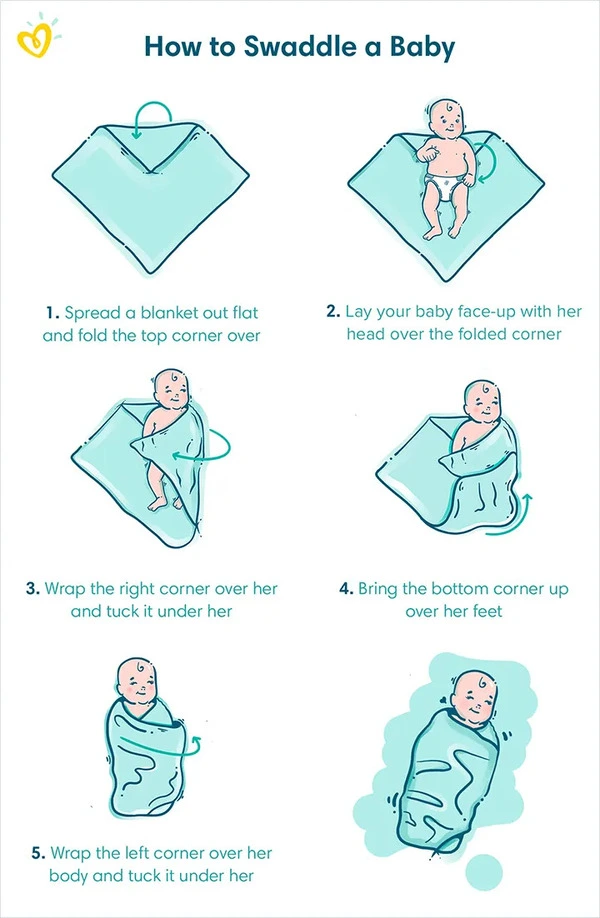
Signs Your Baby Feels Comfortable
Understand your baby’s signals: Babies express their needs through crying, whispering, and body language. When a well-fed and diapered baby is still crying, he or she may be uncomfortable due to the temperature.
Signs of overheating: Overheating in infants can manifest as sweating, rash, wet hair, red cheeks, and rapid breathing. It’s important to note that even if your baby’s hands and feet feel cool, they can still get overheated because their circulatory system is still developing. To check if your baby is comfortable, feel the skin on your baby’s neck, belly, or chest; These areas should be warm but not hot or sweaty. If you suspect your baby is overheating, lower the room temperature or remove a layer of clothing to help your baby cool down quickly because overheating is linked to SIDS.
Signs of feeling cold: When your child is too cold, his or her hands and feet may appear bluish. In such cases, wearing extra clothing or slightly increasing the room temperature may be helpful. There’s no need to worry because your baby’s normal pink color will quickly return.
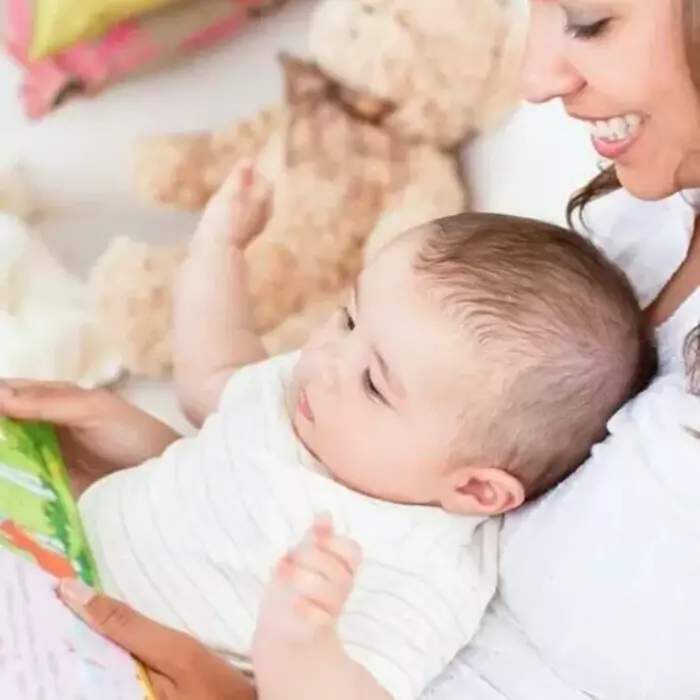
Top Picks for Baby Sleepwear
Know sleepwear they need: Due to the rapid growth of babies, it is not proper to acquire a lot of clothes for sleeping. Generally, four to six pieces of sleepwear are adequate, to ensure that there is always a clean dry piece for the her baby when it is time for sleeping.
Gown-like sleep clothing: It is found that most parents and caregivers prefer to have nightwear and sleepwear that can be opened from the bottom easily. This makes it possible to pull up and down whenever the baby requires a diaper change at night easily In addition, this design makes it easy to pull up and down at night should a baby require a diaper change.
Opt for light layers: It is easier to layer the baby because if the bedroom is cold more layers can be added and if it is hot, some can be removed and it is safer because there is no risk of suffocation.
Avoid safety hazards: Don’t put any clothing, including pacifiers, on babies. Strings and ties increase a baby’s risk of strangulation. Small accessories and pockets in dresses, shirts, trousers, … should be fastened or removed because their loose nature makes them a potential risk of falling off and posing a choking hazard.
Fabric choices: Choose fabrics that are not too tight, synthetic, or stiff, such as organic cotton or any other natural fiber. It is soft to the touch and lightweight thus helping the baby to regulate body heat due to the material used in the making of these fabrics.
Fit: Also, sleepwear should be comfortable but not too tight for the skin. Loose clothing might also become entangled and potentially cause suffocation to the patient.
Swaddling: Swaddling can help babies sleep and encourage them to sleep on their backs while swaddling. But, people must use safe swaddling practices and start weaning from swaddling once the baby starts showing signs of rolling over.
Sleep sacks: Sleep sacks are better than regular blankets. They are wearable and don’t pose a suffocation danger to a child. To the people reading your blog or website, insist on the use of a sleep sack with the correct TOG rating for the room temperature.
Fire safety: When choosing sleepwear, go for the products that have been labeled as flame-resistant.
How to sleepwear for your baby in summer or winter
Sleepwear for your baby in summer
Summer brings sunshine, but it’s important to be extra cautious with newborns who can’t protect themselves from the heat.
During daytime
- For babies under 6 months old, avoid direct sunlight altogether. Their skin is very sensitive and lacks melanin, the pigment that protects against UV rays.
- Dress your baby in just one layer of breathable, lightweight cotton clothing.
- A wide-brimmed hat is a must-have to shield your baby’s face and head from the sun.
- Use a stroller parasol or sunshade to keep your baby cool while you’re out and about. Never drape a blanket or muslin over the stroller, as this can trap heat.
At night time
- Avoid using too many clothes and especially bedding at night period. During mild conditions, it may only require a diaper at night or a light vest, if any at all.
- Baby tends to kick off blankets use them only in a diaper and cover them securely with one sheet. Ensure that the sheet is not too loose so that it can cover the face of the baby or get trapped.
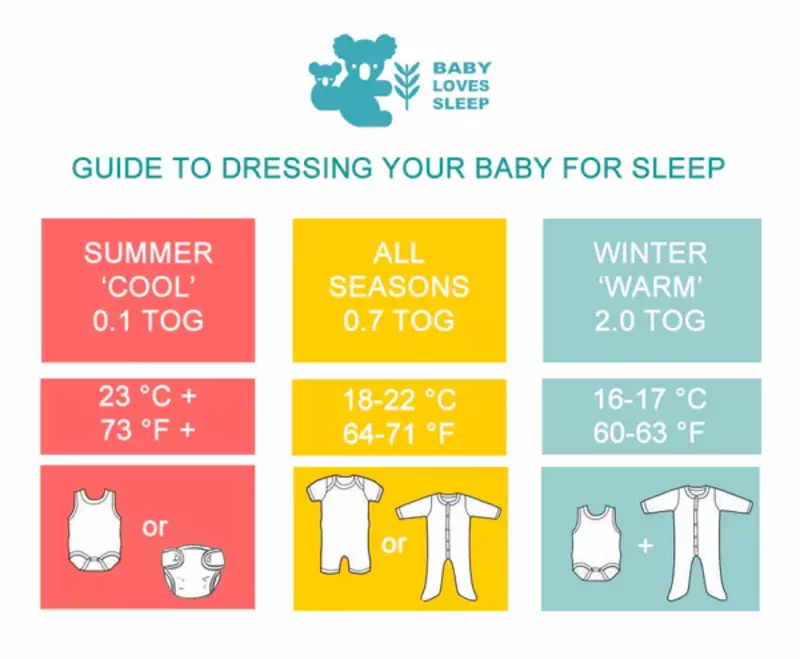
Sleepwear for your baby in winter
During daytime
- A good rule of thumb is to dress your baby in one more layer of clothing than you’re comfortable in. So, if you’re sporting a t-shirt and sweater, dress your baby in a vest, sleepsuit, and a cardigan or jumper.
- Pay attention to your baby’s cues. If you feel cold, chances are your baby does too
- Always remove hats and extra layers when you’re indoors or entering a warm car, bus, or train, even if it means waking your baby briefly. Overheating can be dangerous.
At night time
- While you want your baby to be warm, avoid overheating, which can increase the risk of SIDS.
- A sleepsuit paired with a sleeping bag or a sheet and a lightweight cellular blanket is usually sufficient.
- Using a sleeping bag and suspect your baby might be cold, add an extra layer of clothing underneath, not extra blankets on top.
- Opt for lightweight cellular blankets instead of thick, fleecy, or padded ones for better temperature regulation.
Conclusion
When choosing sleepwear for your newborn, it is important to choose the right sleepwear to ensure your baby’s safety and comfort. When dressing you can wrap your baby to soothe them. But, be sure to wrap them properly and stop when they start to show signs of rolling over. Use sleeping bags for newborns instead of blankets and dress the baby in clothes appropriate to the room temperature.
Sources
- Moon RY, Carlin RF, Hand I, Task Force on Sudden Infant Death Syndrome, Committee on Fetus and Newborn. Available at: https://pubmed.ncbi.nlm.nih.gov/35726558/ ↩︎
- Klass P. (2018). When your baby is your roommate. The New York Times. Available at: https://www.nytimes.com/2018/04/02/well/family/baby-sleep-sids-room-sharing.html ↩︎
- Marcin A. (2019). Swaddling: Definition, how to, safety, and more. Healthline. Available at: https://www.healthline.com/health/baby/swaddling ↩︎


